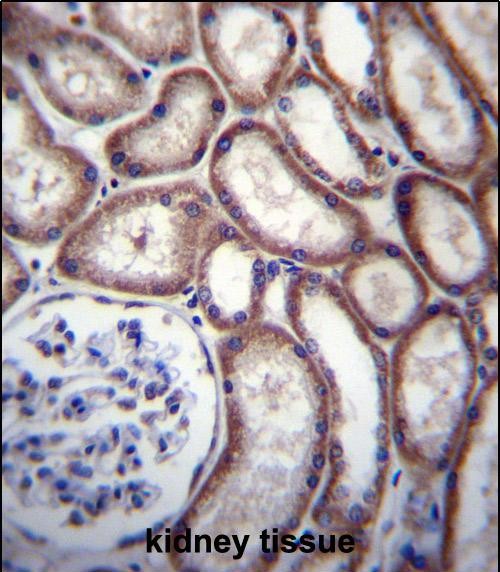DNAJC27 Antibody (N-term)
Affinity Purified Rabbit Polyclonal Antibody (Pab)
- SPECIFICATION
- CITATIONS: 1
- PROTOCOLS
- BACKGROUND

Application
| IHC-P, WB, E |
|---|---|
| Primary Accession | Q9NZQ0 |
| Other Accession | NP_057628.1 |
| Reactivity | Human |
| Host | Rabbit |
| Clonality | Polyclonal |
| Isotype | Rabbit IgG |
| Calculated MW | 30855 Da |
| Antigen Region | 1-30 aa |
| Gene ID | 51277 |
|---|---|
| Other Names | DnaJ homolog subfamily C member 27, Rab and DnaJ domain-containing protein, DNAJC27, RABJS, RBJ |
| Target/Specificity | This DNAJC27 antibody is generated from rabbits immunized with a KLH conjugated synthetic peptide between 1-30 amino acids from the N-terminal region of human DNAJC27. |
| Dilution | IHC-P~~1:10~50 WB~~1:1000 E~~Use at an assay dependent concentration. |
| Format | Purified polyclonal antibody supplied in PBS with 0.09% (W/V) sodium azide. This antibody is purified through a protein A column, followed by peptide affinity purification. |
| Storage | Maintain refrigerated at 2-8°C for up to 2 weeks. For long term storage store at -20°C in small aliquots to prevent freeze-thaw cycles. |
| Precautions | DNAJC27 Antibody (N-term) is for research use only and not for use in diagnostic or therapeutic procedures. |
| Name | DNAJC27 |
|---|---|
| Synonyms | RABJS, RBJ |
| Function | GTPase which can activate the MEK/ERK pathway and induce cell transformation when overexpressed. May act as a nuclear scaffold for MAPK1, probably by association with MAPK1 nuclear export signal leading to enhanced ERK1/ERK2 signaling. |
| Cellular Location | Nucleus {ECO:0000250|UniProtKB:Q8CFP6}. |
| Tissue Location | Overexpressed in gastrointestinal cancers; expression correlates with later tumor-node-metastasis stages of colorectal cancers. |

Provided below are standard protocols that you may find useful for product applications.
Background
Belongs to the small GTPase superfamily. Rab family. 3 isoforms.
References
Gudbjartsson, D.F., et al. Nat. Genet. 40(5):609-615(2008)
Nepomuceno-Silva, J.L., et al. Gene 327(2):221-232(2004)
If you have used an Abcepta product and would like to share how it has performed, please click on the "Submit Review" button and provide the requested information. Our staff will examine and post your review and contact you if needed.
If you have any additional inquiries please email technical services at tech@abcepta.com.














 Foundational characteristics of cancer include proliferation, angiogenesis, migration, evasion of apoptosis, and cellular immortality. Find key markers for these cellular processes and antibodies to detect them.
Foundational characteristics of cancer include proliferation, angiogenesis, migration, evasion of apoptosis, and cellular immortality. Find key markers for these cellular processes and antibodies to detect them. The SUMOplot™ Analysis Program predicts and scores sumoylation sites in your protein. SUMOylation is a post-translational modification involved in various cellular processes, such as nuclear-cytosolic transport, transcriptional regulation, apoptosis, protein stability, response to stress, and progression through the cell cycle.
The SUMOplot™ Analysis Program predicts and scores sumoylation sites in your protein. SUMOylation is a post-translational modification involved in various cellular processes, such as nuclear-cytosolic transport, transcriptional regulation, apoptosis, protein stability, response to stress, and progression through the cell cycle. The Autophagy Receptor Motif Plotter predicts and scores autophagy receptor binding sites in your protein. Identifying proteins connected to this pathway is critical to understanding the role of autophagy in physiological as well as pathological processes such as development, differentiation, neurodegenerative diseases, stress, infection, and cancer.
The Autophagy Receptor Motif Plotter predicts and scores autophagy receptor binding sites in your protein. Identifying proteins connected to this pathway is critical to understanding the role of autophagy in physiological as well as pathological processes such as development, differentiation, neurodegenerative diseases, stress, infection, and cancer.


